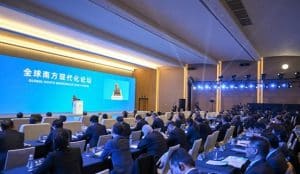A forum entitled “the Hebian Philanthropic Dialogue” took place on June 25th in the small village of Hebian, in Yunnan’s famous Xishuangbanna region, an area bordering Thailand that is well-known for its tropical climate and distinctive local culture. The event was organized by the Xiaoyun Poverty Alleviation Center, with the support of the Southern Public Welfare Foundation (SPWF). During the forum governmental officials, NGOs workers and scholars discussed both the theoretical and practical challenges that charitable organizations face when they engage in poverty alleviation.

Source:ifeng.com
During the first discussion Xu Yonguang, chairman of SPWF, pointed out that the philanthropic sector constitutes a rather small portion of China’s overall socio-economic panorama. In order to play their unique role in society, charitable organizations should pay attention to innovation. Xu also mentioned that the experimental work of the Xiaoyun Foundation in Hebian village is an important example of a philanthropic innovation model, since it effectively responds to deep problems of poverty.
Dr. Lu Dequan stated that current poverty alleviation research often focuses on the perspective of the diversity of poverty. How to integrate the needs of farmers into this perspective is a key step in poverty alleviation. Based on the practical situation of Hebian village, Dr. Lu pointed out that poverty alleviation work in Southwestern China should make sufficient use of the traditional cultural resources of the local ethnic groups in order to draw out the poor’s ability to develop.
In the second part of the forum, the representatives of charitable organizations from across the country shared their perspectives and experiences on the “taking targeted measures for poverty-alleviation” (精准扶贫, jingzhunfupin) policy. Liu Wenkui, secretary general of the China Foundation for Poverty Alleviation (CFPA), briefly reviewed its village-level strategy of poverty alleviation since 2004. After more than 10 years of exploration, the Foundation recognized that the most important factor in driving the villages out of poverty is to encourage the villagers to organize production and business activities. Therefore CFPA has mainly adopted the cooperative model, including the “beautiful village” and “good commune” projects and other projects in a number of villages, in order to carry out poverty alleviation programs.
The vice-chairman Qin Guoying claimed that by centering their projects around women, the China Women’s Development Foundation promotes sustainable rural development and has created a philanthropic brand with mothers as its core. The foundation incorporates gender awareness into poverty alleviation efforts, focusing on effectiveness and combining women’s needs with women’s empowerment. At the same time, Qin also pointed out that most of the charitable organizations concerned with poverty alleviation face problems of insufficient institutional capacity and transparency, which need to be solved urgently.
Michael Hermann, on behalf of Humana People to People, claimed that charitable work should come from the heart and act as a bridge between resources and the villages, and charitable organizations should provide development opportunities for the villagers. Most importantly, they should work on improving the local villagers’ own capacity building. At the same time, Hellman also compared the differences in the model of interaction between governments and NGOs in China and Europe.
Others also commented that as philanthropic development in China picks up speed, the essence of philanthropy remains at the bottom level of society, and more attention should be paid there. Another representative suggested that based on their communication with villagers, the key of the “taking targeted measures in poverty alleviation” strategy is to continuously increase villagers’ income with the help of industry. The current biggest problem is that neither the government nor charitable organizations have sufficient ideas.
The Hebian Dialogue was the first time that representatives of China’s philanthropic sector gathered together in a poverty-stricken village and discussed the theoretical and practical aspects of how their sector should play its present role. The event intends to show that the sector hopes to play an active part in solving social problems.



